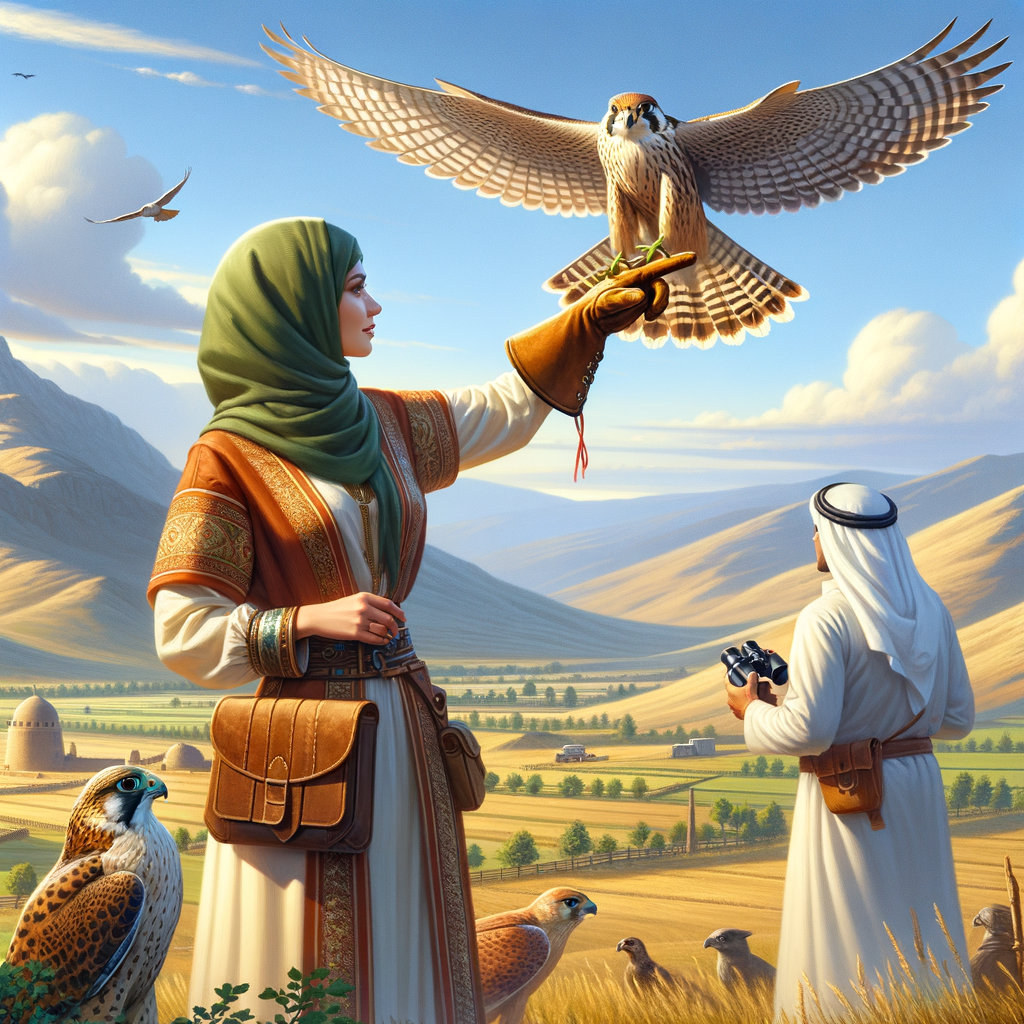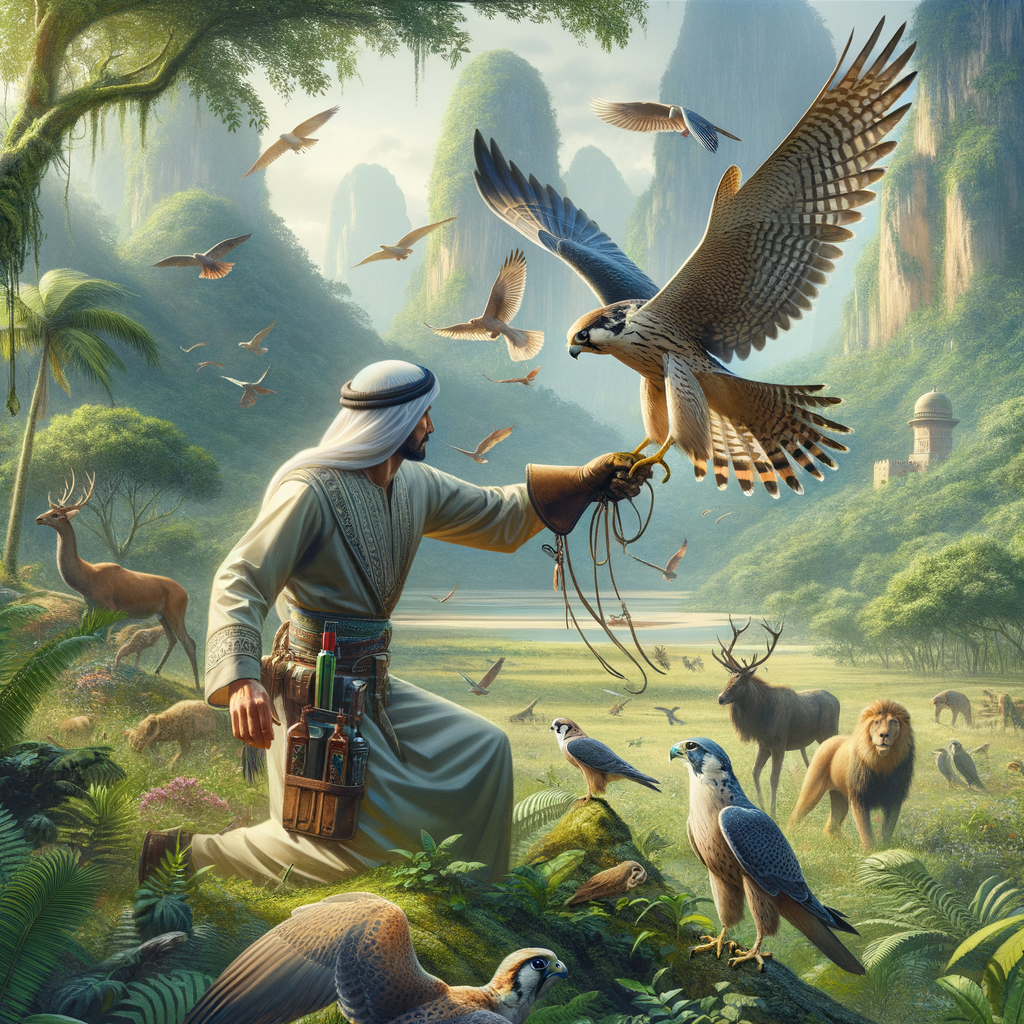Key Insights on Hunting with Falcons
- Introduction to Falconry: Falconry is an ancient practice that involves training birds of prey to hunt.
- Types of Falcons Used: Common falcon species used include the Peregrine Falcon, Gyrfalcon, and the Merlin.
- Training Process: Training a falcon for hunting involves building trust and teaching the bird to return after a hunt.
- Hunting Techniques: Falcons use their incredible speed and sharp talons to capture prey.
- Equipment Needed: Essential gear includes a hood to calm the bird, jesses for control, and a falconry glove.
- Conservation Efforts: Falconry promotes conservation by fostering a deep respect for wildlife.
- Ethical Considerations: Ethical falconry practices ensure the welfare of both the birds and their prey.
- Legal Requirements: Becoming a falconer often requires permits and adherence to specific regulations.
Discover the Thrill of Hunting with Falcons
Imagine you’re standing on the Emerald Isle, gazing out at the rolling green hills of Ireland. The cool breeze carries the scent of heather, and in the distance, a flock of sheep grazes peacefully. Suddenly, a majestic peregrine falcon swooshes down from the sky, its sight set firmly on a swift rabbit. Just as the skilled shepherd knows how to guide his flock with precision and care, a falconer and their bird form an unstoppable team, navigating the wild landscape together. This beautiful and ancient partnership is what makes hunting with falcons so exhilarating.
By keeping your eyes on this page, you’ll uncover not just the “how” but the “why” of falconry. It’s a bit like peeling back the layers of an old Irish tale; each part reveals more depth, excitement, and connection to the natural world. So, grab a comfy seat and let us guide you through the enchanting art of hunting with falcons.
Exploring Falcon Hunting: Techniques and Methods
Hunting with falcons, also known as falcon hunting, is an age-old practice that combines skill, patience, and a deep bond between falconer and bird. This exciting activity is part of a larger tradition called falconry. At Learn Falconry, we are dedicated to helping you understand the art and science of hunting with falcons. Whether you’re a beginner or looking to refine your skills, our resources have you covered. To get started, you can explore the History of Falconry here.
Falconry Hunting Techniques
Falconry hunting techniques are diverse and sophisticated. Each technique requires specific training and practice. For example, the longwing techniques utilize birds with long wings, such as Peregrine Falcons, to catch prey in mid-air. Understanding the species of falcons used for different hunting techniques is crucial. You can learn more about these species here.
- Lure Flying Techniques: This method involves using a lure to train the falcon. The lure mimics the prey and helps the bird practice its hunting skills. It’s a fundamental technique for beginners and seasoned falconers alike. To dive deeper into lure flying, check out our guide on training with lures here.
- Free Flight Techniques: Releasing the falcon to hunt without restrictions is an advanced technique. It requires trust between the falconer and the bird. A well-trained falcon will return to its handler after the hunt. This technique is discussed in detail in our advanced training methods here.
- Creance Training: Using a long, lightweight cord called a creance, falcons are trained to fly and return to the falconer. This step is essential for recall training and sets the foundation for safe free-flight hunting. Learn more about creance training here.
Different Hunting Methods with Falcons
Falconry encompasses several hunting methods, each tailored to the prey and environment:
- Traditional Falconry Methods: These include techniques passed down through generations, such as using falcons to hunt rabbits or birds. Traditional methods respect the cultural and historical aspects of falconry. Discover traditional methods here.
- Modern Falconry Techniques: Incorporating new technologies like GPS trackers and telemetry allows for more effective and safe hunting. Modern methods ensure that the bird’s health and success are continuously monitored. Innovations in gear and technology can be explored here.
- Cooperative Hunting Methods: Involves multiple falconers and birds working together to hunt larger prey. This method enhances the hunting experience and promotes teamwork. Learn about advanced cooperative methods here.
Falconry Equipment
Equipping yourself with the right tools is vital for successful falcon hunting. From gloves to perches, each piece of equipment plays a critical role. For instance, types of hoods help calm the birds by covering their eyes, while bells and telemetry aid in tracking them during hunts. You can browse essential falconry equipment here.
Ethical Considerations in Falconry
Practicing ethical falconry ensures the well-being of the birds and the sustainability of the environment. This includes following legal requirements, respecting wildlife, and employing non-harmful hunting methods. Ethical guidelines and considerations can be found here.
By understanding these different aspects of falcon hunting, you can gain a comprehensive view of the sport and practice it responsibly. Stay engaged with Learn Falconry for continuous updates and education on this fascinating tradition.
Falconry Hunting Techniques and Regulations for 2024
Falconry, the art of hunting with falcons, is a fascinating and ancient practice that requires skills, dedication, and a deep connection with nature. Let’s dive into various aspects of falconry hunting techniques and regulations for the year 2024.
Falconry Season Dates and Bag Limits
Falconry involves specific hunting seasons and bag limits for different types of game. Here is a table summarizing the key information for several species:
| Species | Season Dates | Daily Bag Limit | Possession Limit |
|---|---|---|---|
| Quail | October 1, 2023 to March 31, 2024 | 2 | 4 |
| Gray Squirrel | October 1, 2023 to March 31, 2024 | 12 | 24 |
| Rabbit | Year-round | 12 | 24 |
| Common Gallinule | November 10, 2023 to December 13, 2023 | 3 | 9 |
| Ducks, Coot & Light Geese | November 3, 2023 to November 12, 2023 and February 5, 2024 to February 29, 2024 | 3 | 9 |
| Mourning Dove & Rail | February 1, 2024 to February 17, 2024 | 3 | 9 |
| Woodcock | November 24, 2023 to December 17, 2023, and February 1, 2024 to March 9, 2024 | 3 | 9 |
Pennsylvania Falconry Regulations
In Pennsylvania, falconry hunting periods are structured a bit differently. For instance, squirrel hunting is permitted from September 1, 2023 to November 11, 2023, and from November 13, 2023 to November 25, 2023, with the same daily and possession limits as mentioned in the general guidelines.
Techniques in Falconry Hunting
Different techniques are used in falconry based on the type of birds and the environment. Here’s a breakdown:
Longwings (Falcons):
- Direct Pursuit: Falcons are flown directly from the falconer’s fist or perch, using their speed and agility to catch prey in flight.
- Waiting-on: Falcons soar high above the falconer, waiting for prey to be flushed, and then swoop down swiftly to capture it.
Shortwings (True Hawks):
- Perch Hunting: Birds like goshawks or sparrowhawks are flown either from trees or the falconer’s fist, relying on their fast, powerful wing flaps to catch prey.
Broadwings (Eagles and Buzzards):
- Soaring: Broadwings hunt while soaring in the sky, typically over hilly or mountainous terrain, making use of their keen eyesight to spot and dive toward prey.
Methods of Communication and Training
Falconers employ various techniques to control and communicate with their birds during a hunt:
- Visual and Oral Signals: These signals help maintain control and allow the bird to respond efficiently.
- Species-Specific Training: Different species have innate abilities and must be trained according to specific methods that suit their natural hunting styles.
Becoming a Falconer
Embarking on the falconry journey involves significant commitment. Prospective apprentices should find a seasoned falconer to sponsor them. It’s important to read recommended falconry texts and prepare for the state falconry exam, which requires a minimum passing score of 80%.
Falconry Education and Sponsorship
To become a falconer, one must learn extensively from experienced practitioners. They provide invaluable knowledge and mentorship, guiding new enthusiasts through the intricacies of the sport.
Utah’s Hunting Regulations for 2024
In Utah, hunting regulations include various permits and quotas:
- General-Season Deer Hunting: 71,525 permits, with specific management units for buck-to-doe ratios.
- Elk Hunting: Includes different categories such as any bull elk and spike bull elk with a combined total of 49,626 permits.
- Other Species: Specific quotas for pronghorn, moose, bighorn sheep, and more.
This structured approach ensures sustainable wildlife management and conservation efforts.
Summary
Falconry is an engaging and ancient sport that demands dedication and education. With specific hunting seasons, techniques, and guidelines, prospective and seasoned falconers can continue to enjoy and preserve this unique tradition in 2024.
Embracing Falconry Hunting in 2024
Embarking on a falconry journey in 2024 is more than just a hobby; it’s a deep dive into an ancient art. Whether you’re aiming to catch quail, squirrel, or rabbit, understanding the specific hunting seasons and bag limits is crucial. Falconry involves different techniques, such as direct pursuit, waiting-on, perch hunting, and soaring, each adapted to the unique skills of the bird species.
Becoming a falconer requires dedication and commitment. Getting a sponsor and preparing for the state exam are essential steps. Remember, falconry is not just about the hunt; it’s about the bond between you and your feathered partner. By adhering to regulations and embracing the art of falconry, you contribute to a tradition rich in history while enjoying the thrill and responsibility of the hunt.
Happy Falconing! Make this year your most adventurous yet with the extraordinary world of falconry.



